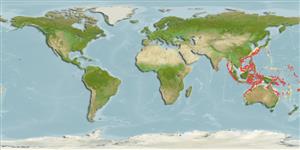>
Zeiformes (Dories) >
Parazenidae (Parazen) > Cyttopsinae
Etymology: Cyttopsis: Greek, kyttaros, kytos = a convex cavity + Greek, opsis = appearance.
More on author: Fowler.
Environment: milieu / climate zone / depth range / distribution range
Ökologie
seewasser benthopelagisch. Tropical
Western Pacific: southeast Asia and the northern Australia.
Size / Gewicht / Alter
Maturity: Lm ? range ? - ? cm
Max length : 7.8 cm SL Männchen/unbestimmt; (Ref. 5978)
Occurs on the continental shelf and continental slope. Benthic species (Ref. 75154).
Life cycle and mating behavior
Geschlechtsreife | Fortpflanzung | Ablaichen | Eier | Fecundity | Larven
Kailola, P.J., 1987. The fishes of Papua New Guinea. A revised and annotated checklist. Vol. 1. Myxinidae to Synbranchidae. Research Bulletin No. 41. Department of Fisheries and Marine Resources, Port Moresby, Papua New Guinea. 194 p. (Ref. 6993)
IUCN Rote Liste Status (Ref. 130435: Version 2024-1)
Bedrohung für Menschen
Harmless
Nutzung durch Menschen
Tools
Zusatzinformationen
Download XML
Internet Quellen
Estimates based on models
Preferred temperature (Ref.
123201): 11.6 - 21.8, mean 15.9 °C (based on 235 cells).
Phylogenetic diversity index (Ref.
82804): PD
50 = 0.8125 [Uniqueness, from 0.5 = low to 2.0 = high].
Bayesian length-weight: a=0.01738 (0.00668 - 0.04524), b=3.00 (2.78 - 3.22), in cm total length, based on LWR estimates for this (Sub)family-body shape (Ref.
93245).
Trophic level (Ref.
69278): 3.4 ±0.8 se; based on size and trophs of closest relatives
Fishing Vulnerability (Ref.
59153): Low vulnerability (10 of 100).
